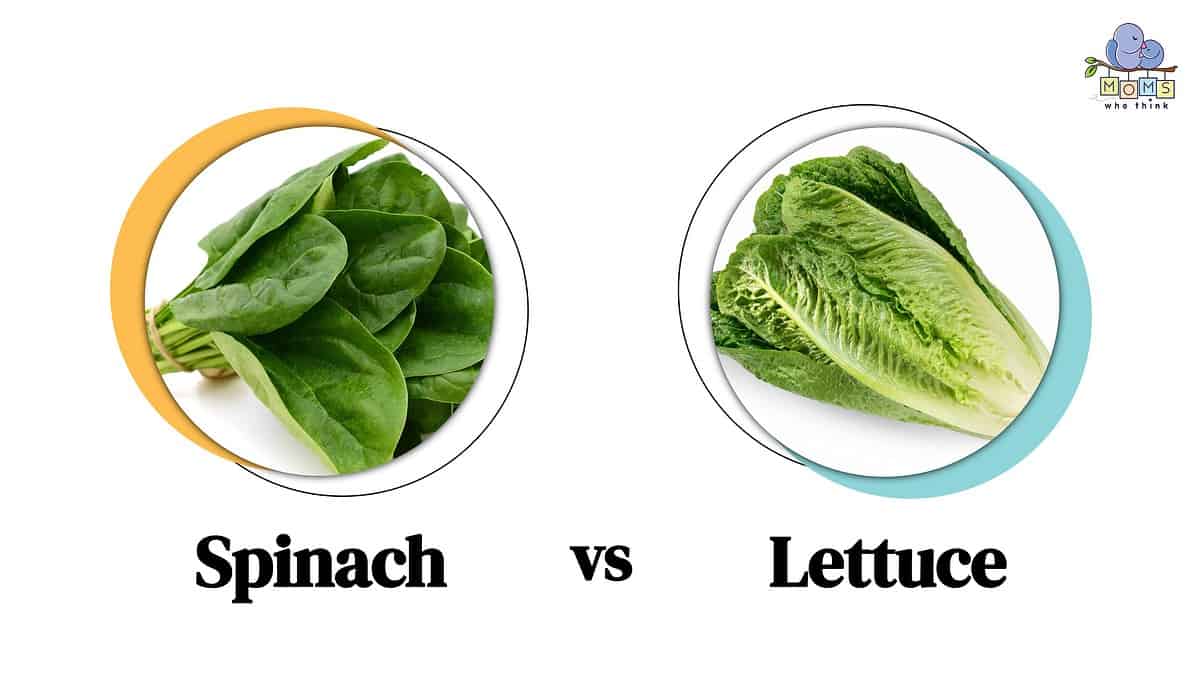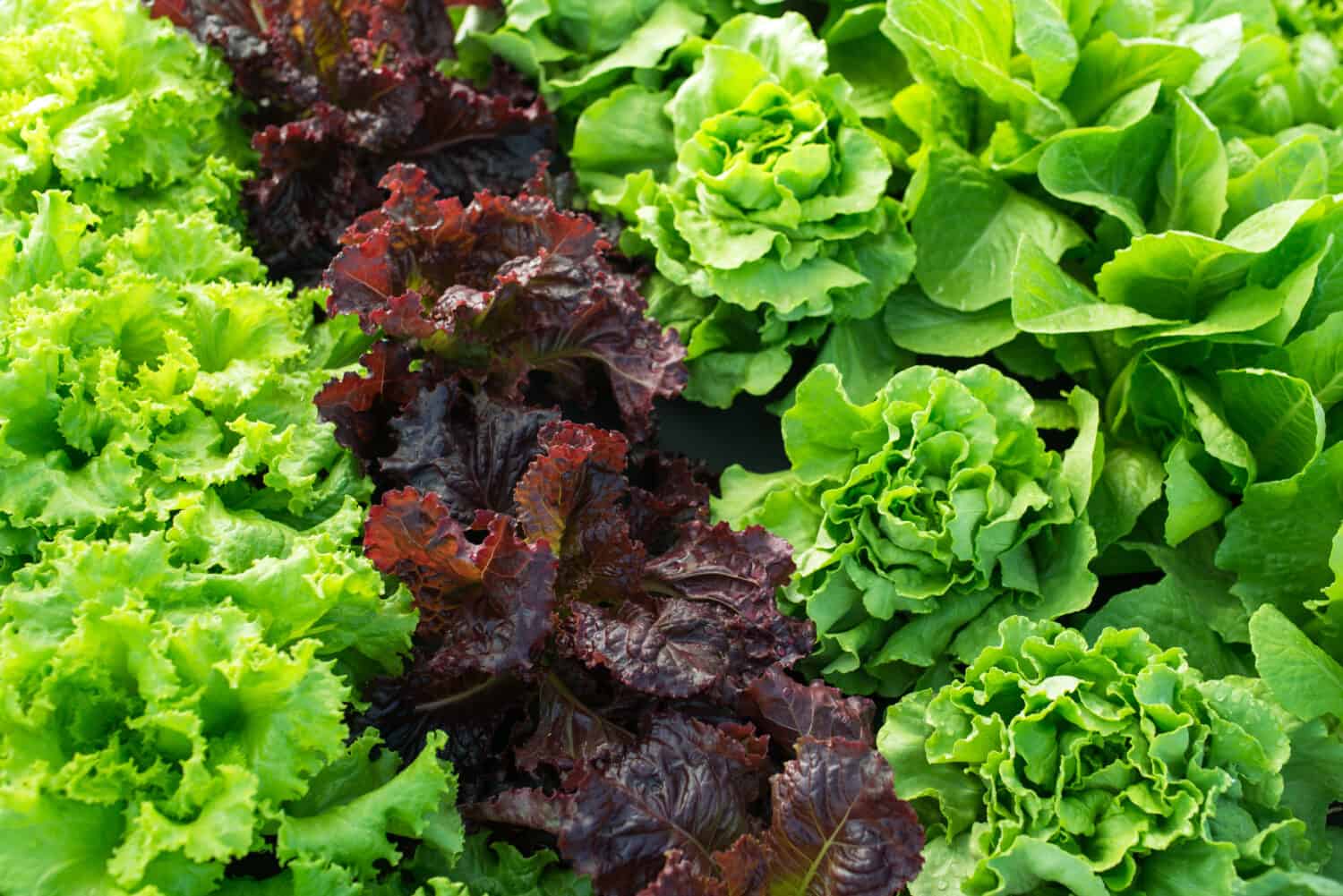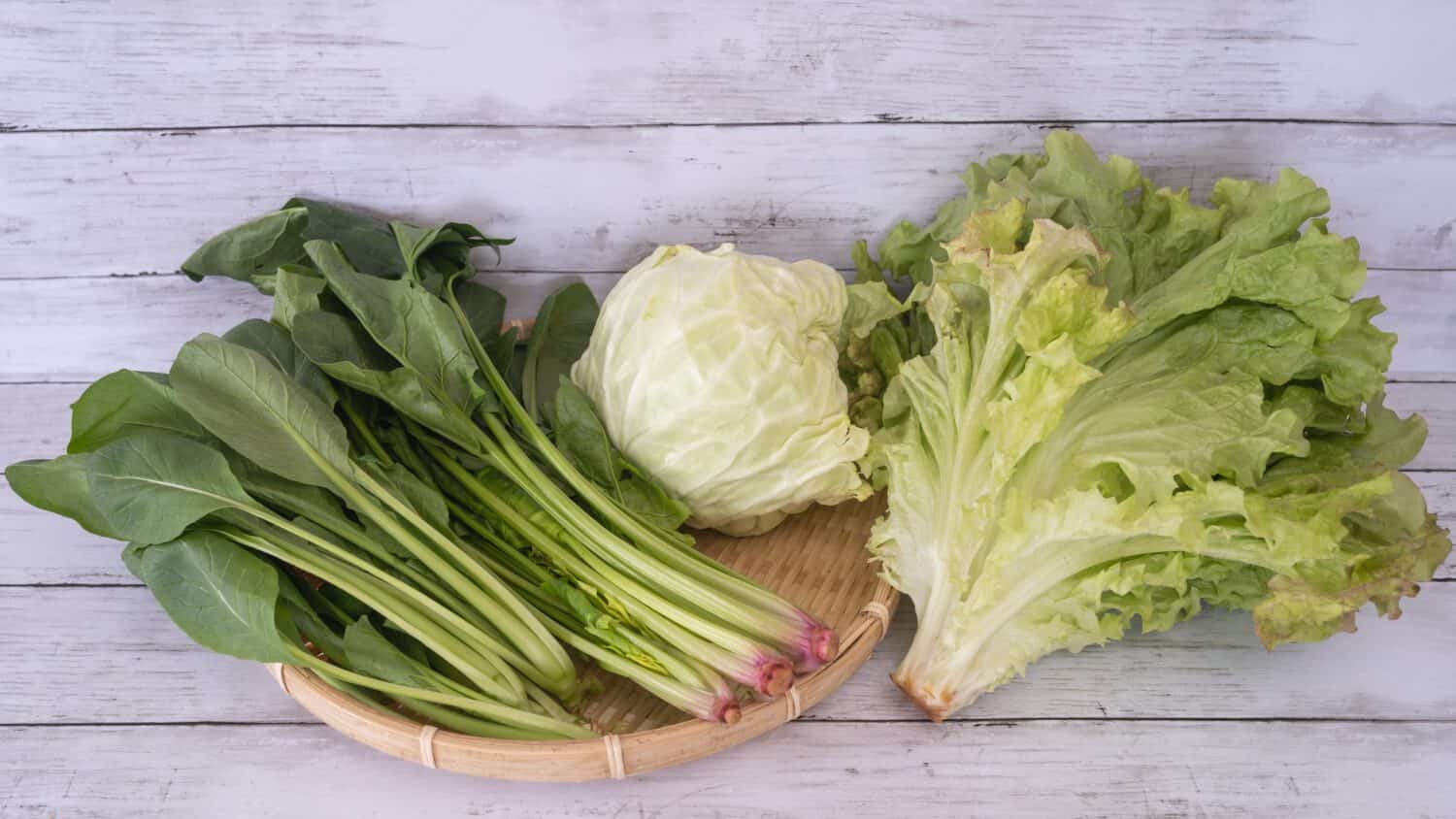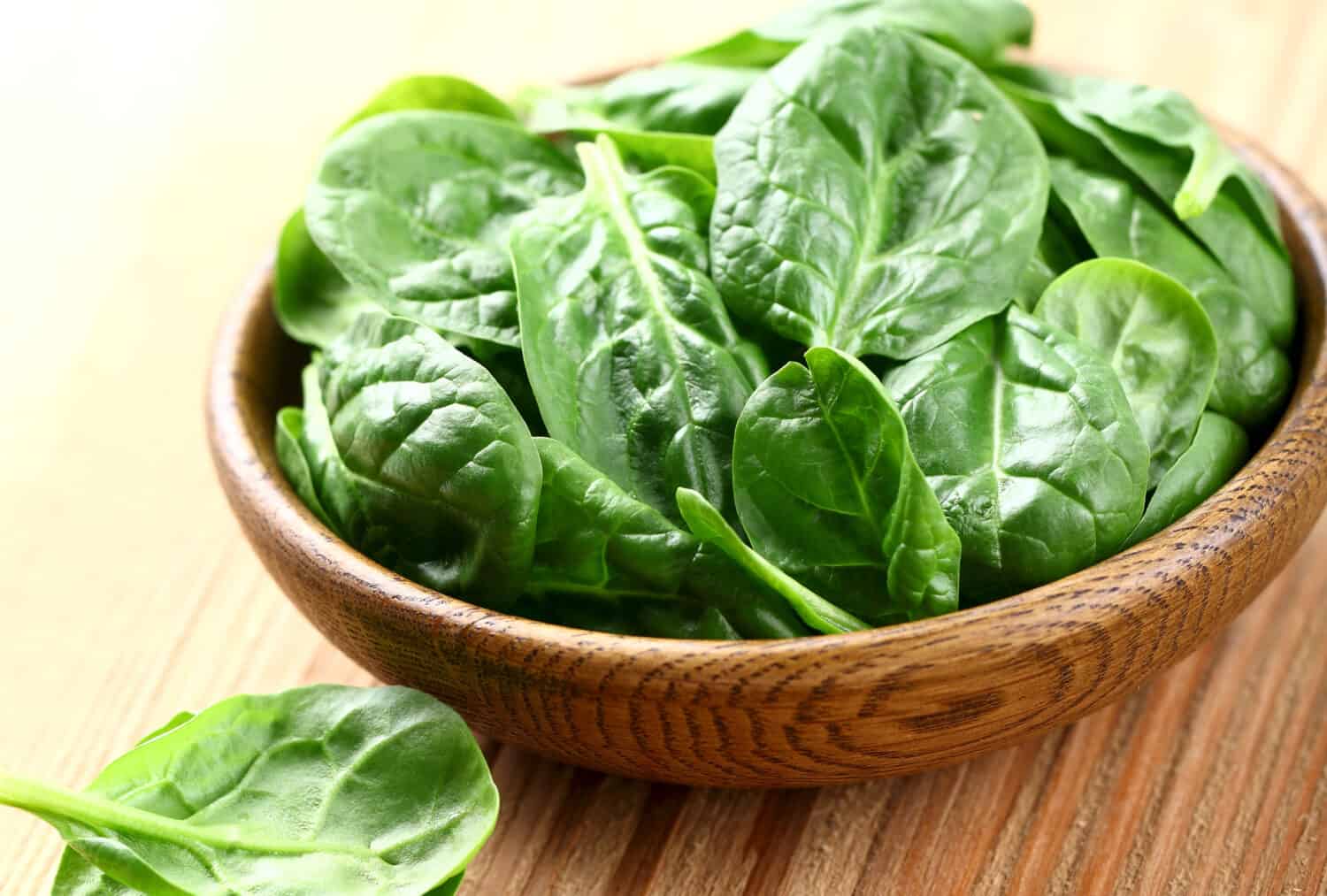Spinach and lettuce are two popular leafy greens that are highly nutritious and low in calories, making them great additions to any diet. However, choosing between the two can be difficult as they both offer unique health benefits. Both greens are rich in essential vitamins and minerals and can be used in a variety of dishes, including salads, sandwiches, wraps, and smoothies.
We will compare the nutritional profiles of spinach and lettuce to determine which green vegetable provides more health benefits. So, let us find out which one wins the battle between spinach and lettuce.

©
Spinach vs. Lettuce: What Is Spinach?
Originating in Persia, spinach (Spinacia oleracea) is a leafy green vegetable that belongs to the Amaranthaceae family, which also includes beets, quinoa, and Swiss chard. Spinach has a slightly bitter, earthy flavor and dark green leaves. Moreover, it can be eaten raw or cooked.
Spinach contains several important plant compounds that aid the body in a number of ways.
- Lutein – Lutein has antioxidant properties and supports eye health. Research suggests that a diet rich in lutein may help reduce the risk of age-related macular degeneration (AMD) and cataracts, two common eye conditions that can lead to vision loss.
- Kaempferol – This antioxidant compound may help decrease inflammation in the body. Researchers believe it may have anti-cancer properties and may slow the progress of neurodegenerative diseases like Alzheimer's. Finally, this compound may reduce cholesterol and blood pressure.
- Quercetin – Studies show that this compound reduces inflammation from chronic diseases and may improve heart health by lowering blood pressure and improving blood vessel function.
- Zeaxanthin – Like lutein, zeaxanthin supports eye health and may reduce the risk of age-related macular degeneration (AMD).
The Health Benefits of Spinach
It's a well-known fact that spinach offers many health benefits, including promoting eye health, fighting cancer, and regulating blood pressure. However, there are some downsides to spinach.
One of the negative effects of spinach is that it can cause kidney stones. Spinach is rich in calcium and oxalates, which can lead to the formation of kidney stones. Therefore, people who are at risk of developing kidney stones should avoid consuming spinach.
Moreover, spinach helps in blood clotting, which can be problematic for people who are on blood thinning medications. Those taking blood thinners to prevent clotting should avoid spinach since it contains high levels of Vitamin K, which causes blood clotting.

©Teri Virbickis/Shutterstock.com
Spinach vs. Lettuce: What Is Lettuce?
Lettuce belongs to the Asteraceae family, which also includes daisies and sunflowers. This leafy green vegetable commonly appears raw in salads and as a topping for sandwiches, wraps, and other dishes. Lettuce has four different types, each with unique characteristics in terms of flavor, texture, and appearance.
- Celtuce lettuce – Asparagus lettuce or stem lettuce, also known as celtuce lettuce, is a type of lettuce with a thick stem that people typically eat instead of its leaves. People eat celtuce raw in salads, stir-fried, pickled, or added to soups and stews. It has a mild, slightly sweet flavor and a crunchy texture that resembles that of a cucumber. Celtuce lettuce is more popular in Asian countries like China than in Western countries.
- Head lettuce – Head lettuce, which includes iceberg and butterhead lettuce, is named after its tightly packed head. This kind of lettuce has a mild taste and is slightly sweet with crisper leaves—this is the kind of lettuce that most often appears in salads and sandwiches.
- Leaf lettuce – Leaf lettuces have a looser leaf structure and are not tightly packed. Some of these lettuces are darker in color or have reddish leaves, like red leaf lettuce and oak leaf lettuce. The leaves of these lettuces have a mild flavor and a more delicate texture than other kinds of lettuce.
- Romaine lettuce – Romaine lettuce, which is also known as Cos lettuce, is a type of lettuce that has long and slender leaves that are closely packed together. This lettuce variety has a crunchy texture and a slightly bitter taste. It commonly appears in Mediterranean cuisine, especially in dishes like Caesar salad and Greek salad. Additionally, it is used as a bread or tortilla substitute in sandwiches and wraps.
The Health Benefits of Lettuce
Like spinach, lettuce is low in calories and rich in essential nutrients, including vitamins A, K, and C, as well as minerals like potassium and folate. Furthermore, lettuce has a lot of water, so it aids in hydrating the body. Moreover, lettuce contains dietary fibers, which aid the digestive system.
Additionally, lettuce contains antioxidants, including beta-carotene and flavonoids, which can help reduce inflammation and stress in the body, potentially lowering the risk of chronic diseases like heart disease and certain cancers. Its fiber and antioxidant content may also be good for the heart by reducing inflammation, lowering cholesterol levels, and maintaining healthy blood pressure. Some studies also suggest that lettuce may improve sleep quality.
However, it is important to understand that different types of lettuce have varying levels of vitamins and nutrients. Moreover, it is crucial to wash lettuce thoroughly before consumption to eliminate dirt, bacteria, and pesticide residue. Despite these considerations, incorporating different varieties of lettuce into your diet can provide you with a range of vitamins and nutrients.

©YARphotographer/Shutterstock.com
Spinach vs Lettuce: Nutritional Information
Spinach is packed with nutrients such as vitamins A, C, and K, folate, iron, and calcium. It is also rich in antioxidants like lutein and zeaxanthin, which are essential for eye health. Additionally, it contains fiber, which aids in digestion and promotes a healthy digestive system.
Not only is lettuce low in calories and carbohydrates, but it contains some vitamins and minerals, such as vitamin A, vitamin K, and folate. However, these are generally lower amounts compared to spinach. Lettuce is also a hydrating food due to its high water content, which can help in maintaining overall hydration and improve skin health. However, it is important to note that different types of lettuce have varying nutrient levels. Darker lettuce varieties, such as romaine lettuce, have more nutrients than lighter varieties, like iceberg lettuce.
Here is a comparison chart to outline the nutritional values of spinach vs. lettuce.

©
Spinach typically provides more vitamins and minerals than lettuce. However, this nutritional breakdown shows that both leafy greens are nutritious options.

©aomas/Shutterstock.com
In Summary
Both spinach and lettuce offer unique health benefits as nutritious leafy greens. Spinach, in particular, is more nutrient-dense than lettuce because it is rich in vitamins and minerals, including vitamin A, vitamin C, iron, and calcium. These vitamins make spinach an exceptionally healthy food. Additionally, spinach contains the antioxidants lutein and zeaxanthin, which benefit eye health. However, spinach may cause kidney stones and should be avoided by people using blood thinners.
Lettuce, on the other hand, is a valuable source of vitamins and minerals such as vitamin A, vitamin K, and folate, although it is lower in nutrients compared to spinach. Moreover, lettuce provides hydration to the body due to its high water content. However, the nutrient content of lettuce varies among different varieties. Darker lettuce varieties, like romaine lettuce, contain more nutrients than lighter varieties, such as iceberg lettuce. Finally, it is very important to wash lettuce to avoid bacteria, dirt, and pesticides.
The bottom line? Consuming both spinach and lettuce in a variety of dishes is essential for a healthy diet. Both provide vital nutrients and contribute to overall well-being.
Print
Creamy Chicken Spinach Soup
- Total Time: 45 minutes
Ingredients
- 1 (9 ounce) package refrigerated cheese tortellini
- 1 (14 1/2 ounce) can fat-free, reduced-sodium chicken broth
- 2 (10 3/4 ounce) cans reduced-fat, reduced-sodium cream of chicken soup
- 1 (10 ounce) package frozen chopped spinach, thawed and squeezed dry
- 1 (9 ounce) chicken breast, chopped and cooked
- 2 cups fat-free milk
- 1/2 teaspoon dried thyme
Instructions
- Cook tortellini according to package directions, using 1 can broth instead of water. Add soup and remaining ingredients stirring well.
- Bring to a boil; cover, reduce heat to medium, and cook until thoroughly heated.
- Prep Time: 15 minutes
- Cook Time: 30 minutes
- Category: Soup
- Method: Simmering
- Cuisine: American
The image featured at the top of this post is ©Dionisvera/Shutterstock.com.

